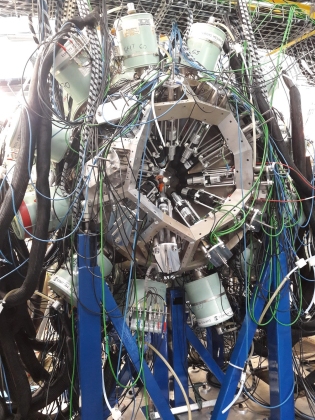How is angular momentum generated in nuclear fission?
2021-02-25

A series of measurements performed at the Laboratory of the Physics of the two infinities Irène Joliot-Curie (IJCLab) in France resulted in a key observation that allows to explore the mechanism of angular momentum generation in nuclear fission. Analysis of the properties of radiation emitted in the fission reactions of the 238U, 232Th, and 252Cf atomic nuclei revealed no correlation between the angular momenta of the resulting fission fragments. This latest finding implies that, contrary to the predictions of most fission models, the sources of angular momenta are separate, and it must be generated after the nucleus splits. The results, published in the Nature journal, are the effect of collaboration between physicists from the international Nu-ball research group, including researchers from the Faculty of Physics of the University of Warsaw.
When an over-inflated balloon bursts, its pieces fly away in opposite directions performing various air evolution. The process of nuclear fission, in which a nucleus is split into two parts accompanied by the emission of several neutrons, proceeds similarly. The energy released in this process manifests itself not only in the form of the kinetic energy of the created fragments, but also in the form of rotation and other nuclear excitations. One of the accompanying phenomena is the emission of gamma-ray quanta, which lifts not only the excess energy created but also the angular momentum (i.e. inhibit rotation).
For over 40 years, the conditions for the appearance of high angular momentum in a fission system, where the angular momentum was practically zero, remained experimentally unexplored. In particular, it was not clear whether this high angular momentum arises before or after the atomic nucleus splits into smaller fragments. A decisive conclusion in this matter was reached thanks to a series of experiments performed at Laboratoire de Physique des 2 Infinis Irène Joliot-Curie (IJC) in Orsay, France.
The results, published in the Nature journal, are the effect of cooperation of physicists from 37 institutions (from 16 countries), including Faculty of Physics, University of Warsaw, forming Nu-ball collaboration. The leading role in research was due to IJC, where, since 2018, over 1200 hours of measurements with collimated beam of fast neutrons were performed in the ALTO facility. Neutrons impinged on a target with fissionable materials, 238U or 232Th, and induced a nuclear fission. An additional measurement was performed with a spontaneously fissioning 252Cf nuclei. A gamma radiation, accompanying the fission, was recorded by over 200 detectors, and casades of gamma transitions in over 30 nuclei were reconstructed. As a result of analysis, it was concluded that there is no correlation in the emitted radiation between the fission fragments. This means that, contrary to the most of the currently used nuclear fission models, the sources of angular momentum are separate, and the fragments do not exchange information. A new model was proposed, in which the fissioning nuclei forms a neck, and after it breaks, two separate fragments with very elongated shapes appear. The new systems tend towards a spherical shape, and the energy associated with the deformation is converted into excitation of the newly formed atomic nuclei. The proposed process explains the statistical nature of excitations, independent for each fission fragment.
The data obtained by the physicist from the Nu-ball group are relevant to nuclear reactor modeling, where gamma radiation and its multiplicity are important components of the heat transport calculations. They are also important in the production of new superheavy elements and exotic nuclides with large neutron excess.
Scientific paper
Wilson, J.N., Thisse, D., Lebois, M. et al. Angular momentum generation in nuclear fission. Nature 590, 566–570 (2021)
https://www.nature.com/articles/s41586-021-03304-w
Co-authors from the Faculty of Physics UW:
Ewa Adamska, Victor Gauadilla, Agnieszka Korgul, Krzysztof Miernik, Monika Piersa





